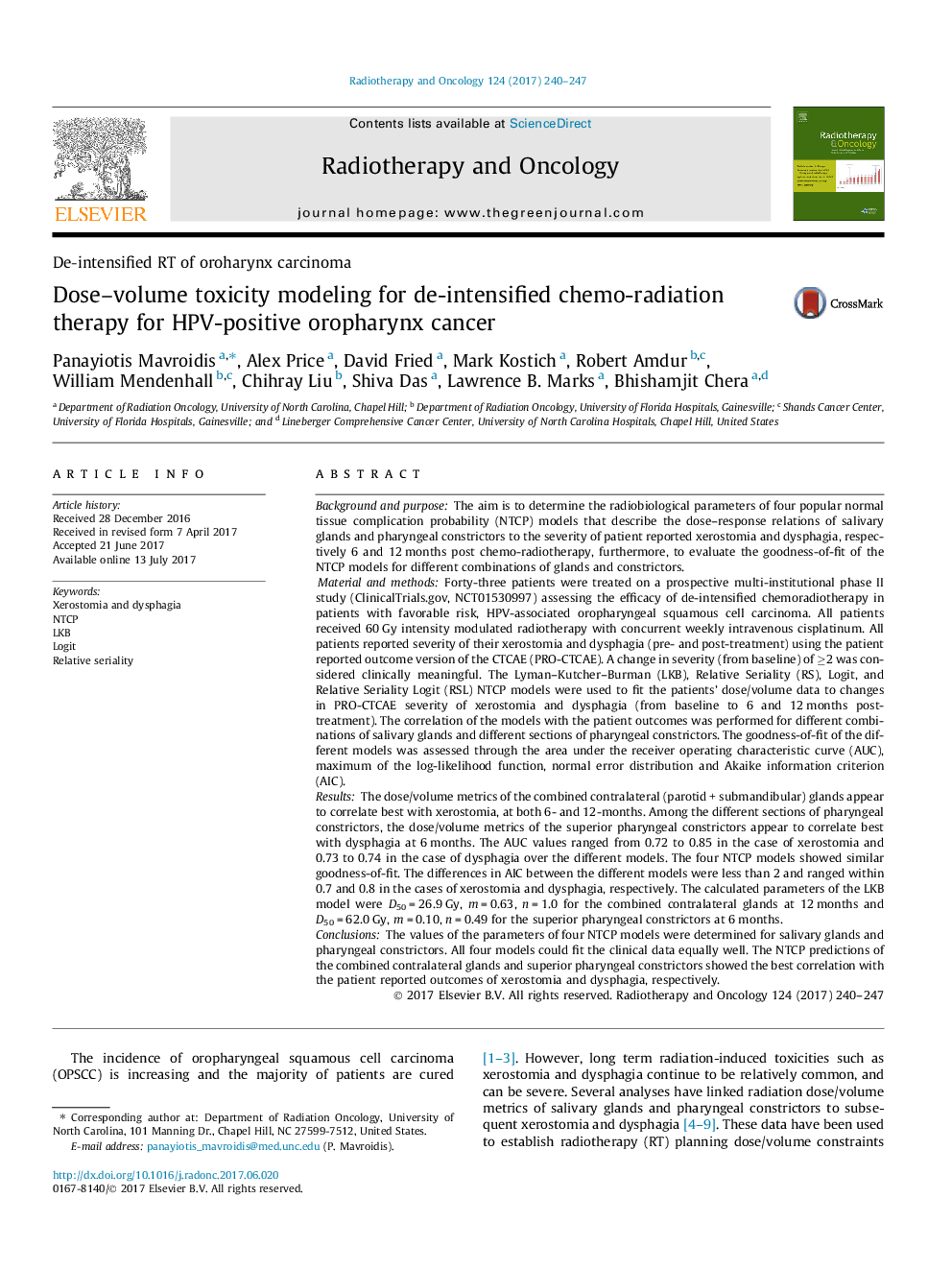| کد مقاله | کد نشریه | سال انتشار | مقاله انگلیسی | نسخه تمام متن |
|---|---|---|---|---|
| 5529468 | 1401699 | 2017 | 8 صفحه PDF | دانلود رایگان |

Background and purposeThe aim is to determine the radiobiological parameters of four popular normal tissue complication probability (NTCP) models that describe the dose-response relations of salivary glands and pharyngeal constrictors to the severity of patient reported xerostomia and dysphagia, respectively 6 and 12 months post chemo-radiotherapy, furthermore, to evaluate the goodness-of-fit of the NTCP models for different combinations of glands and constrictors.Material and methodsForty-three patients were treated on a prospective multi-institutional phase II study (ClinicalTrials.gov, NCT01530997) assessing the efficacy of de-intensified chemoradiotherapy in patients with favorable risk, HPV-associated oropharyngeal squamous cell carcinoma. All patients received 60 Gy intensity modulated radiotherapy with concurrent weekly intravenous cisplatinum. All patients reported severity of their xerostomia and dysphagia (pre- and post-treatment) using the patient reported outcome version of the CTCAE (PRO-CTCAE). A change in severity (from baseline) of â¥2 was considered clinically meaningful. The Lyman-Kutcher-Burman (LKB), Relative Seriality (RS), Logit, and Relative Seriality Logit (RSL) NTCP models were used to fit the patients' dose/volume data to changes in PRO-CTCAE severity of xerostomia and dysphagia (from baseline to 6 and 12 months post-treatment). The correlation of the models with the patient outcomes was performed for different combinations of salivary glands and different sections of pharyngeal constrictors. The goodness-of-fit of the different models was assessed through the area under the receiver operating characteristic curve (AUC), maximum of the log-likelihood function, normal error distribution and Akaike information criterion (AIC).ResultsThe dose/volume metrics of the combined contralateral (parotid + submandibular) glands appear to correlate best with xerostomia, at both 6- and 12-months. Among the different sections of pharyngeal constrictors, the dose/volume metrics of the superior pharyngeal constrictors appear to correlate best with dysphagia at 6 months. The AUC values ranged from 0.72 to 0.85 in the case of xerostomia and 0.73 to 0.74 in the case of dysphagia over the different models. The four NTCP models showed similar goodness-of-fit. The differences in AIC between the different models were less than 2 and ranged within 0.7 and 0.8 in the cases of xerostomia and dysphagia, respectively. The calculated parameters of the LKB model were D50 = 26.9 Gy, m = 0.63, n = 1.0 for the combined contralateral glands at 12 months and D50 = 62.0 Gy, m = 0.10, n = 0.49 for the superior pharyngeal constrictors at 6 months.ConclusionsThe values of the parameters of four NTCP models were determined for salivary glands and pharyngeal constrictors. All four models could fit the clinical data equally well. The NTCP predictions of the combined contralateral glands and superior pharyngeal constrictors showed the best correlation with the patient reported outcomes of xerostomia and dysphagia, respectively.
Journal: Radiotherapy and Oncology - Volume 124, Issue 2, August 2017, Pages 240-247